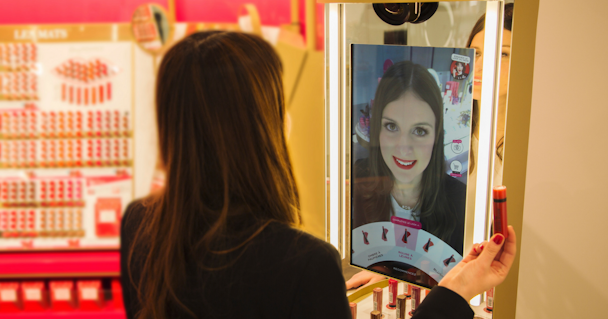Augmented reality needs to demonstrate consistent value and utility before mainstream adoption grows
Over the past few years, the trajectory of the augmented reality (AR) industry has been tumultuous at best.

augmented reality mirror / Coty
Consumers gushed over Snapchat’s AR hotdog. They sang their hearts out through AR Facebook filters when Taylor Swift released her Reputation album. And when Pokemon Go exploded, they ran around their neighborhoods, schools, and local parks chasing fictional creatures as if their lives depended on it. It seemed like the game might be the catalyst that AR enthusiasts had been waiting for. But when even the hype around Pokemon Go dissipated into just another fad, industry leaders were again left asking, When will AR have its blast-off moment?
The short answer? It might not. But that’s not a bad thing.
There’s a more efficient and realistic way to drive consumer adoption of AR, and it doesn’t have anything to do with a singular tipping point. Instead, consistent mainstream adoption will take hold when the utility and practicality of the technology creates real, tangible value for those who would use it in their everyday lives.
Instead of one-and-done AR campaigns where there is little incentive for consumers to engage with the technology consistently, the evolution of AR needs to focus on adding value by solving problems consumers face in the various facets of their lives.
Industries like retail, education, and healthcare have massive opportunities to utilize AR in increasingly convenient and meaningful ways. Once companies more regularly integrate AR into their broader customer experience strategies, consumers will also be able to interact with the technology on a more consistent basis. Here are three examples of brands across several industries using AR to provide more value to their customers:
‘YouCam’ Makeup Try-On: AR isn’t new to the retail space, as dozens of brands have heightened their efforts to reach consumers through tactics like AR scavenger hunts and other similar engagement campaigns -- but the virtual try-on application is one of the most integrated tools along the consumer’s journey. Target, Revlon and several other top beauty brands have recently adopted the YouCam technology, which has more than hundreds of millions of global downloads. In fact, most beauty brands employ some kind of AR try-on technology and L’Oreal acquired Modiface earlier this year.
The technology allows users to layer makeup products over a live photo of their face to see exactly how a certain shade of lipstick or specific eyeshadow would look on their skin. Rather than a direct customer engagement play, this use of AR builds credibility with consumers by eliminating a common issue they face when it comes to makeup shopping: the messy, time-consuming act of physical try-ons, or the worry of purchasing a product they haven’t tested out.
Google Expeditions: The presence of AR in both primary and secondary education is growing, adding a new, interactive layer to students’ traditional learning. From exploring Leonardo Da Vinci’s inventions, to getting up close and personal with a strand of DNA, Expeditions offers more than 100 AR ‘tours’ of different places, moments, and advancements related to a variety of school subjects. The Google Expeditions app can be used as a hands-on supplement to teachers’ curriculums, allowing students to experience the often intangible information found in textbooks.
3D4Medical: Due to the intricate level of AR design needed for the medical field, this industry has been slower to adopt the technology. However, companies like 3D4Medical are revolutionizing how healthcare students and professionals will study and practice medicine on patients. At a time where patient interactions with doctors last no more than 17 minutes on average, this technology has the ability to advance doctor-patient communication. The app creates an AR human body that can be tailored to replicate each patient’s specific injury or illness, honing in on how it affects the rest of their body. The ability to personalize the AR technology on a case-by-case basis in real time allows doctors to help patients understand their ailments and treatments with more clarity and efficiency.
AR on its own is an interesting digital tool for a wide array of institutions, enterprises, and brands to interact with customers, students and professionals, but it must be integrated into a broader business strategy to deliver maximum effectiveness.
Google’s introduction of its AR Maps functionality for directions and recommendations in local neighborhoods is a great example of how the technology continues to evolve and better solve problems at scale. Ultimately, it will be up to companies to demonstrate their commitment to enhancing customer experience by delivering utility and value to people’s everyday lives through AR. From there, mainstream consumer adoption won’t be far behind.
Mikela Druckman is chief commercial officer at Blippar
